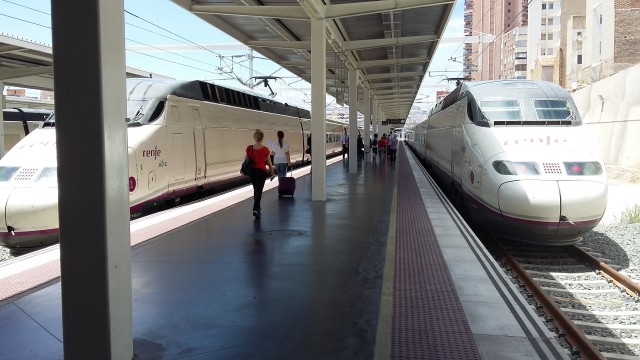
Platform at Alicante station – Photo: Ant Richards
Spain is a proud and mesmerizing nation, perched on the Iberian Peninsula on the southwestern tip of Europe. A country that conjures many festive, passionate, and eye-watering images, as well as its fair share of sometimes erroneous stereotypes. It’s a stretch of land that is as diverse in its geography as its people, cuisine, customs, and its four official languages ’“ yes, contrary to what many believe, there are four main languages and a few offshoots from some of these that are just as official.
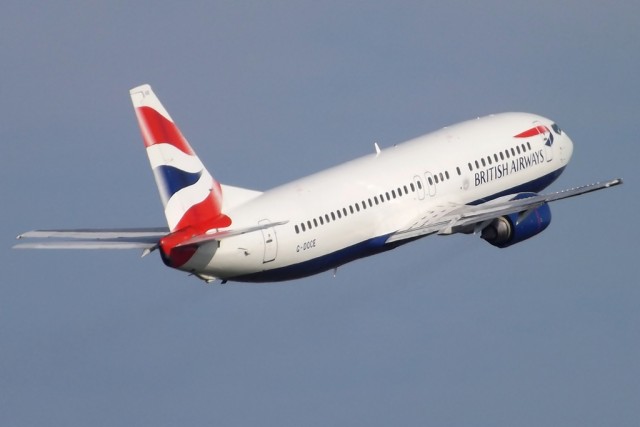
A classic Boeing 737-400 for British Airways – Photo: Mark Harkin | FlickrCC
Spain is much more than just bullfights, tapas, siestas, soccer, loud neighbors, and flamenco. It is one of the world’s tourist powerhouses, and for good reason. Spain is a country that I tend to visit quite often, for family and other practical reasons; my main destination being Madrid.
On this occasion, however, my Iberian travels took me to Alicante. A coastal city that lies on the Costa Blanca, Alicante is the second largest city in the Comunitat Valenciana, after its capital, Valencia. My final destination would be Calpe.
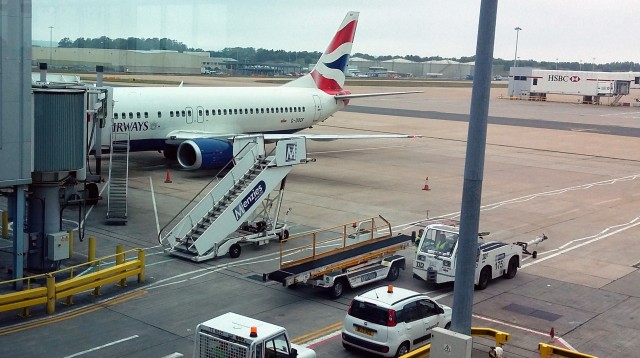
British Airways Boeing 737-400 – Photo: Ant Richards
STAGE ONE: British Airways Club Europe Flight to Alicante
For a decent price, I booked Club Europe (“Business Class”) on the London Gatwick (LGW) to Alicante (ALC) leg, and economy on the Madrid-London return flight.
I checked in online and confirmed my seat: 3F. Then, after having risen at an ungodly hour, I left my home in southeast London (Saaffeest, as a true SE Londoner would say) at 4:30 AM to get to LGW.
The bag dropping process at check-in probably lasted all of three minutes, after which I went through the quasi-strip ritual of security, took a quick browse at the duty-free shops, and arrived at the British Airways Terrace Lounge.
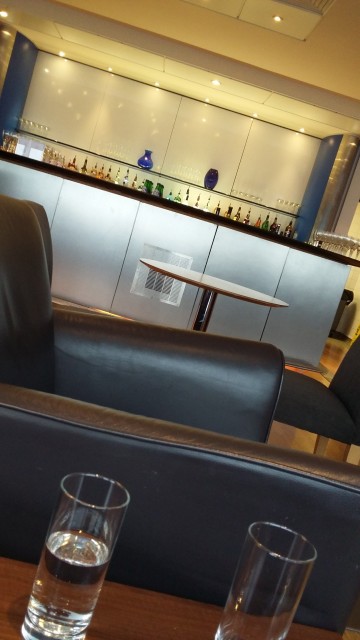
Drinks inside the BA lounge at LGW – Photo: Ant Richards
Despite this airport being BA’s second hub, their lounge has a more tranquil feel than its Heathrow counterparts, which I find overcrowded, untidy, and at certain hours chaotic.
Just at the stroke of 8:00 AM, and about an hour after I had my breakfast, I decided to avail myself of a rather naughty glass of Albarià±o, that superb white wine from the Galician region. Well come on, I was going on holidays and erm… I was already setting myself to Spanish time … which is one hour ahead of the UK… sounds about right? Right?
As no boarding calls are made inside the lounge, I checked the board at around 8:30 AM and a gate number was already assigned, so I headed out on the 10-minute walk to the boarding area. It was a full flight, and shortly after I arrived boarding commenced. Despite the full capacity, boarding was carried out in an orderly fashion. Push back was on-time.
The Club Europe cabin on my Boeing 737-400 had the same seating as economy, just an extra inch or so more legroom and the middle seat empty. Fortunately, this aircraft still had the older, more-padded (albeit dated) seating. For a two-hour flight it was fine, but not what I would call luxurious.
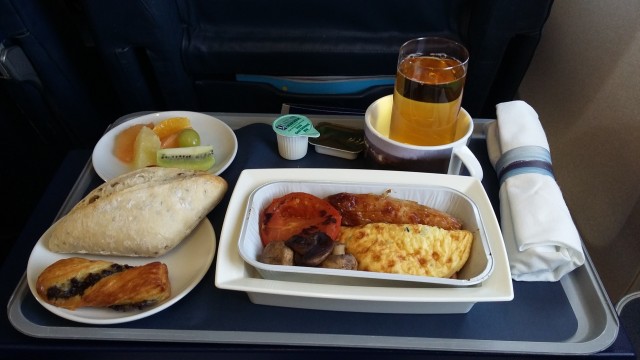
Club Europe’s full breakfast offering – Photo: Ant Richards
Catering started as soon as we reached our cruising altitude, and the two cabin staff came around and took my breakfast order. I went for the full breakfast, which consisted of scrambled eggs, bacon rasher, sausage, grilled tomato, grilled mushrooms, and a choice of hot bread or sweet pastries. I chose one of each, plus a small fruit platter, as well as a drink – apple juice in my case.
The trays were cleared soon after, and that left me some time to start work on this review and catch up with some reading. My plane did not have any entertainment system other than the in-flight magazine.
We landed right on schedule at 12:35 PM local time. After a short five-minute taxi to the gate, the chaotic deplaning took place. I spent about 35 minutes waiting for my bags, which was quite annoying.
My expectations going into my flight were pretty low, and they were met. In the end, I don’t see the point in this type of indulgence for a short flight, even with such a great deal. But, I had at least arrived at my destination.

Platform at Alicante station – Photo: Ant Richards
STAGE TWO: Train to Madrid
I had done some research before booking this ticket. I debated on whether to travel by plane or train. I went with the train, because it was cheaper and I hadn’t done a long rail journey in Spain for almost 20 years.
I purchased a standard Tourist-class ticket, a semi-flexible fare at about $43.
I found a public car park very close to the main station, dropped the car, and having just under two hours before my departure, I decided to briefly explore the seafront and part of the Old Town.
Just after 2:00 PM, I walked into Alicante’s main rail station. Unlike the grand rail structures you would find in larger cities, like Madrid or Barcelona, Alicante’s station, in line with the city’s size, is quite small yet easily laid out and not at all crowded.
The Tourist-class carriages are quite airy and seating is comfortable for these fast journeys. Seats are configured in forward-or-backward-facing sets of two; four-seaters with a folding table separated them in the center of the car.
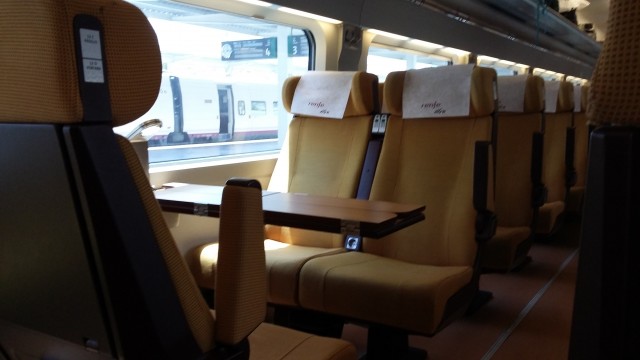
Seating inside AVE’s tourist carriage – Photo: Ant Richards
My seat, 13B, was an aisle on a forward facing two-seater. Luckily for me, the other seat was unoccupied.
We left on time at 2:30 PM, and in a few minutes, the AVE (Spain’s high speed train) gathered speed and soon we were whizzing through the dry Levanthian countryside.
The total journey time was a bit more than two hours, with just one stop in the city of Albacete. Although quite a few more people boarded at this station, I still ended with an empty window seat, so I decided to move and enjoy the scenery to Madrid.
As far as entertainment is concerned, there were three drop-down screens over the aisle, and on this occasion, a French film (dubbed in Spanish) played throughout the journey.
After leaving both stations, the train inspector walked through the train handing out headphones. There was also a buffet coach where you can purchase food and drink, but I didn’t have the need.
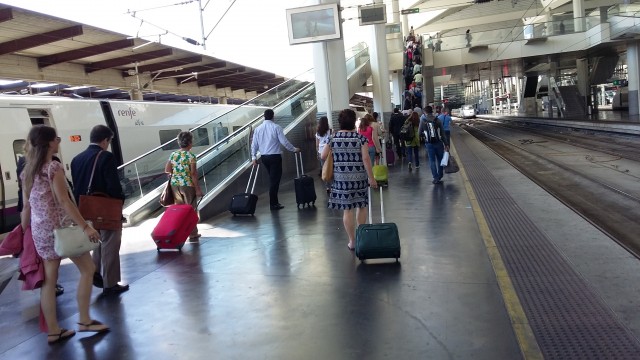
Arriving in Madrid’s Atocha station – Photo: Ant Richards
Eventually, I arrived into Madrid Atocha station at 4:42 PM, on the dot. At the station, one has the option of catching the Metro, mainline rail for destinations in the Madrid periphery, a taxi, or local buses.
For speed, value, and convenience, I strongly recommend the AVE trains where available. These now connect Madrid with many main cities, amongst them Barcelona, Seville, and Valencia. I ended up enjoying it more than my British Airways flight, and going rail was the right call!
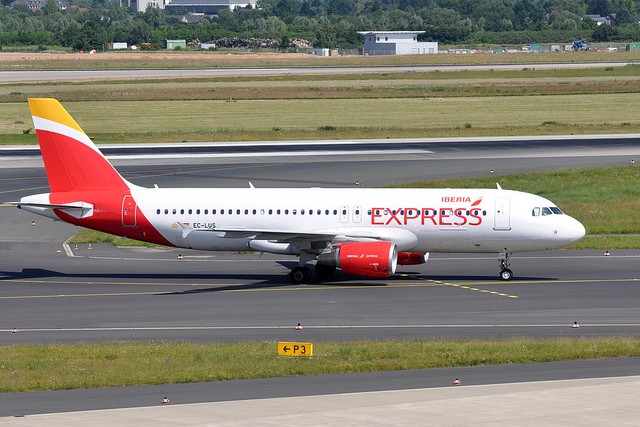
Iberia Express Airbus A320 – Photo: Eric Salard | FlickrCC
STAGE 3: British Airways Iberia Express Economy Back to London
Online check-in was more complicated than it should have been. Basically, it never happened. I managed to download something resembling a barcode on my smartphone, but when I tried to retrieve it at the airport, it either expired, disintegrated, or got abducted by aliens.
Apparently, if you are traveling on a British Airways ticket number, operated by Iberia, online check-in is not possible. So much for code-share, airline alliances, and streamlining passengers’ travel experience. And to believe that British Airways and Iberia are in effect the same airline…sigh. A 20-minute queue saw me finally able to check my suitcase and get my boarding pass.
Luckily, once I completed the process, I was offered the fast-track security channel thanks to my oneworld Sapphire status. Iberia, together with its Oneworld partners, operate out of Madrid’s modern T4 and its satellite T4S. The “fast track” lane lived up to its purpose, and in just under three minutes I cleared security and then headed for Iberia’s Dali lounge.
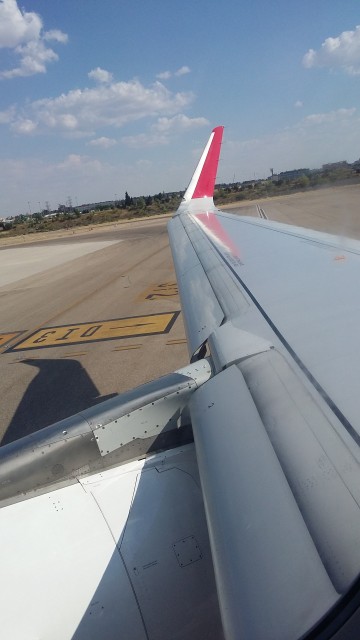
Wingtips on IB A320-200 – Photo: Ant Richards
T4 is actually the main terminal building, while T4S is the satellite located about 2 km away on the other side of one of the airport’s four runways. One would be inclined to believe that satellite is in another city; a different time zone, even.
At about 5:20 PM, I saw that the gate was open for boarding, so I left the lounge and walked to the gate. By the time I arrived, I noticed there were probably only four or five people behind me left to board.
The flight was full, operated by Iberia’s new low-cost offspring Iberia Express. It was quite obvious that the “Express” was more about low-cost than about speed.
Seats on my Airbus A320 were well maintained; light grey leather upholstery, with white paneling and bright red headrests – they gave a clean and fresh feel to the cabin. The pitch, however, was a different story. Not being a large person myself, I still struggled to squeeze through to my window seat with the aisle and middle seat already occupied. Fortunately, I would only endure it for one hour and 50 minutes.
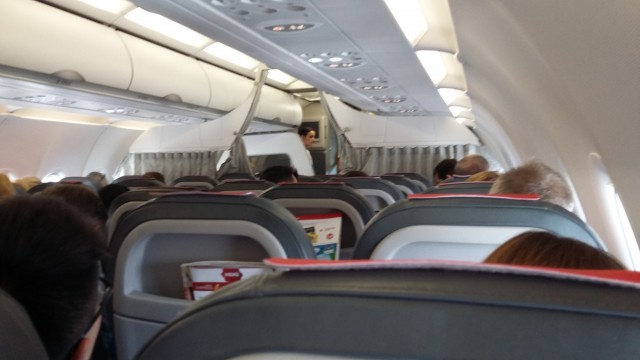
Economy cabin layout on Iberia Express – Photo: Ant Richards
We took off on schedule, and as soon as cruising altitude was reached, the in-flight service started. Leaving aside the seat and in-flight magazines, everything else on board is for purchase. Not even water was offered for free!
Having wolfed down a generous helping of sandwiches, wraps, mini chorizos, and the odd glass of Rioja in the lounge, nutrition was not high on my in-flight priorities. Unfortunately, due to the tight legroom and having had to store my wheelie bag a few rows away from my seat, I was unable to work, so I passed on the flight reading (Iberia’s Ronda magazine) and blasted my cool rock selection on my smartphone.
We landed ten minutes ahead of schedule, parking shortly after at our air bridge in Terminal South. The usual scrum to deplane was followed by an almost marathon walk to immigration, which at that time of the evening was fairly busy.
I must admit that I had not been a huge fan of Iberia, but my latest experiences have been quite positive in terms of timely departure, interaction with their check-in staff, etc. Despite the low-cost structure, my recent flight experiences have been quite pleasant.
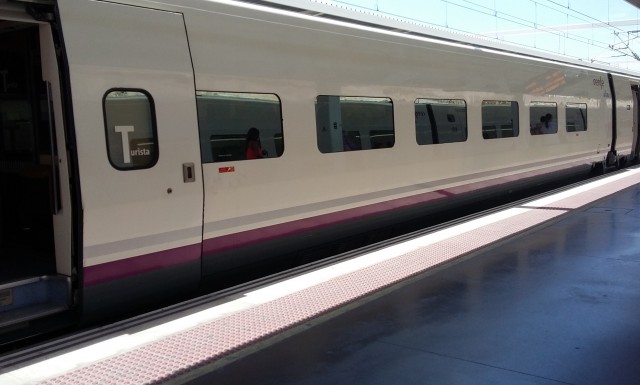
AVE train – Photo: Ant Richards
The Plane-Versus-Train Conclusion
Looking at it from a legacy airline point-of-view, non-stop flights between the UK and Spain will invariably involve oneworld carriers like Iberia and BA, in addition to the odd Vueling (now part of BA/IB parent company IAG) flight, so it works well for me.
While BA can be sometimes hit-and-miss, Iberia is more miss-and-hit, however, I have noticed signs of improvement with the latter. That said, for these types of flights, I am happy to continue accruing my miles and points with these carriers.
With regards to the overland journey from Alicante to Madrid, traveling on the AVE was the best idea, even for a plane enthusiast like me. Sometimes it’s good to see the world at ground level. Provided you can arrange through a reputable and straight-forward website (and there are a couple of decent ones) you are in for a safe, fast, reliable, and stress-free journey on the AVE, and best of all, city-centre to city-centre!
The author, Ant Richards, is a life-long airliner enthusiast, based in London. He divides his time between working as a business travel consultant for a leading TMC company, traveling, and writing. He published his first novel in July 2014 and is currently completing work on a collection of short stories.
hello Ant,
Great article. I travel to and within Spain regularly; although not much in train.
I have a question about your train experience: when you board the train and are carrying luggage, where do you leave the luggage? By your side or in a luggage section. If at a luggage section, then how do you secure it so no one else walks out with it while you are not paying attention.
Regards,
Ray.
hi Ray
Your baggage is located within a car near you. No one can take it unless they are willing to exit a train moving at speed above 100 plus mph. The stations are secure and there is usually a walk from the train to the exits. Therefore, anyone taking your bag would have to travel some distance past,security to get out of the station. Most train cars have many people on board and everyone seems to be alert of who is doing what. Put small locks on your bags, keep an eye out during station stops and you’ll be just fine.
Hi Ray,
Aplogies for my late reply. Being on a different time zone means I only just saw your comment now. I echo Rich’s comment re the luggage. In addition, there are racks above the seats for smaller bags.
The rule of thumb would be to simply keep vigilant when stopping at an intermediate station just in case. In any case there are always inspectors on board who are quite efficient in maintaining safety and order.
Cheers,
Ant
Ray,
I travel very frequently by train in Germany with occasional international travel to other European cities for many years. I had never lost my luggage or gotten my luggage stolen.
Deutsche Bahn ICE, SNCF and Thalys TGV, and à–BB Railjet have luggage sections with two or three shelves in each carriage where the passengers can leave their luggage. This one is in Deutsche Bahn ICE:
http://www.desiro.net/ICE-Fensterplaetze-klein.jpg
This one in à–BB Railjet: https://myaliyah.files.wordpress.com/2011/01/dsc00691.jpg (Notice the glass divider? That’s luggage section).
Where the groups of vis-à -vis seats abut each other like in this photo, the luggage can be left in the space between seats. They are more common in Swiss Railway.
http://www.hochgeschwindigkeitszuege.com/deutschland/fotos-deutschland/ice-t-2-klasse-tisch-kl.jpg
If you have a serious trust issue, you can elect to use the six-seat compartment rooms with larger overhead luggage shelves like this one where you can watch your luggage the whole time:
http://koehler.tstgmbh.de/images/ice3innen1klasseabteil_600.jpg
Deutsche Bahn has door-to-door luggage service for additional fee.